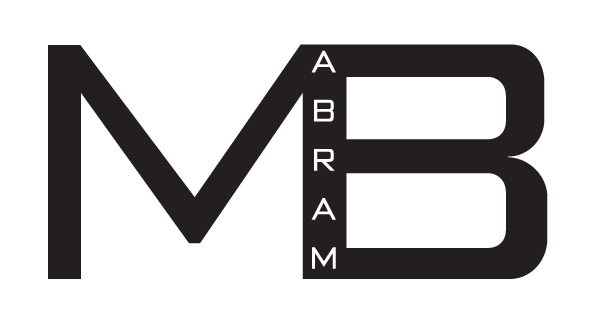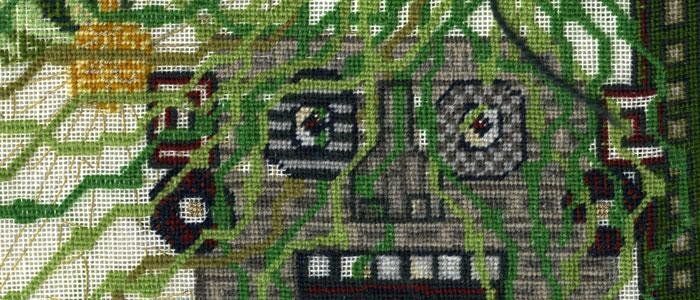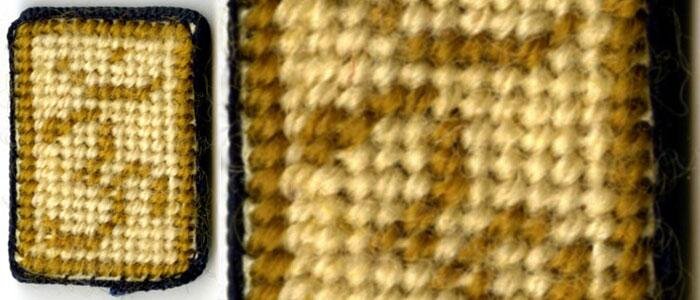Conversations With Artists: The Jan Haag Collection
September 2010
Thank you for your continued interrest in our selection of original art and artifacts. We have just posted the astonishing artwork of June Wayne (click here). Please enjoy your visit to Wayne's work, as well as our rare collection of contemporary and ancient art (click here). This work will be renewed next week by works of a water theme paralleling our newest episode of Artists of the Seas conversation (click here). By popular demand, we continue to present here the work and conversation of master needlepoint artist Jan Haag.
Best regards,
MB
We inaugurated our Conversations with Artists series in March with Los Angeles based artist and architect Ted Tokio Tanaka. For friends who missed Ted's inspirational story, that conversation remains available for viewing on our site here.
The crew of MB Abram Galleries recently traveled to Seattle to chat with Jan Haag in her Good Shepherd studio about the
Haag Needlepoint Collection.
For visual experimentation spanning 33 years, Jan chose a medium rarely associated with contemporary art. Working in the needlepoint grid became a primary way for Jan of understanding both the world and her experience in it. The works memorialize and transmit knowledge of a lifetime of reflection and travel, often on foot in remote cultures. Contained within these works are not only the powerful subjective awareness of light and color, but the pleasure associated with study -- in this case, the study of music, astronomy, mathematics, travel, archaeology, and the iconographic, mystical and esoteric traditions of many cultures. Through Jan's efforts, needlepoint and its possibilities have forever been transformed.
This work has been exhibited in solo exhibits at the Seattle Asian Art Museum and other venues, but this is the first time that Jan has discussed for the camera her work and the inspirations for it. The 23 works are available as a collection to a qualified museum or collector.
click for expanded biography
There are 12 videos and 22 high resolutions scans here. Please enjoy our conversation with a great talent and personality.
1996-2001 MUKHRA/TUKRA/CHAKRADAR IN TINTAL & RUPAKTAL
Single strand Persian wool; double strand Appleton wool; lace wool, partly Kashmir; silk yarn; rayon yarn; cotton and viscose yarn; cotton, silver and gold thread on 18 mesh canvas, Continental stitch in all four directions. Approximately 154,548 stitches.
Dimensions: 18 x 26 ½ in
1981-1991 & 1995 KALACHAKRA
Single strand Persian wool, gold thread, on 18 mesh canvas. Continental stitch in all four directions
Approximately 107,254 stitches
Dimensions: 24 3/4 x 13 3/8 in
1991-1992 & 1995 PALIMPSEST
Single strand Persian wool, double strand Appleton wool, gold, silver and silk thread, on 18 mesh canvas
Continental stitch in all four directions
Approximately 67,473 stitches, 424 stitches per square inch
Dimensions: 17 x 12 ¼ in
1987-1988 ASIAN DIARY #1, Kundalini
Single strand Persian wool, gold thread, on 16 mesh canvas. Continental stitch in all four directions
Approximately 77,280 stitches
Dimensions: 17 1/4 x 17 ½ in
1988-1989 ASIAN DIARY #2
Single strand Persian wool on 16 mesh canvas.
Continental stitch in all four directions
Approximately 60,372 stitches
Dimensions: 14 5/8 x 16 1/8 in
1982-1987 GREAT-GRANDMOTHER'S LEGACY
Double strand Persian wool on 14 mesh canvas. Continental stitch in all four directions. Approximately 47,736 stitches,
Dimensions: 13 5/8 x 17 7/8 in
1994 TINTAL COIN PURSE
Single strand Persian wool and double strand Appleton wool on 18 mesh canvas, covering both sides of a canvas and plastic coin purse, with metal zipper. Continental stitch in all four directions
Approximately 6,378 stitches
Dimensions: 3 3/4 x 5 ¼ in
1995
KAIDA IN TINTAL, Tabla Covers
Single strand Persian wool, double strand Appleton wool, and gold thread, on 18 mesh canvas:
Continental stitch in all four directions.
Dimensions: Baya (left drum) cover, 10 1/8 x 10 1/8 in. (approximately 33,216 stitches)
Tabla (or Daya, right drum) cover, 6 3/8 x 6 3/8 in (approximately 13,168 stitches)
1975-76 UNICORN
Double strand Persian wool on 12 mesh canvas
Continental stitch in all four directions
Approximately 29,736 stitches,
Dimensions: 14 3/4 x 14 in
1979 ARMRESTS, for 1964 Riviera
Double strand Persian wool on 12 mesh canvas. Continental stitch in all four directions. Approximately 22,104 stitches in the pair,
Each: 15 x 2 3/4 x 1"
1996-2006 THE TEN THATS
Embroidery cotton, lace and Appleton wool, string cotton, gold and silver thread on gray, 22 mesh canvas,
Continental stitch in all four directions, embroidered accents
Approximately 77,000 stitches
Dimensions: 11 x 14 ¼ in
1995-1996 TUKRA IN TINTAL, Tabla Covers
Baya (left drum) cover: Single strand Persian wool, double strand Appleton wool on 18 mesh canvas, approximately 40,100 stitches
Tabla ( or Daya, right drum) cover: Single strand Persian wool, double strand Appleton wool, and rayon on 18 mesh canvas, approximately 13,168 stitches
Continental stitch in all four directions
Dimensions: Left drum cover 11 1/8 x 11 1/8 in; Right drum cover 6 3/8 x 6 3/8 in
Tukra means "little piece." The Tukra that inspired this set of tabla covers was the first tabla composition I learned to play well enough to enjoy practicing. It also initiated a new direction in my "musical" needlepoints. For the first time I stitched the bols in Sanskrit.
As I worked with the Sanskrit syllables (in Devanagari), many questions about the complexity of the bols were answered i.e. the similarity of the form of the dha and dhin as syllables (the former struck -- for the theka -- on kinar and the latter struck on sur) is like their similarity as tabla strokes; the differentiation between dhin (played on sur) and din (played on gaab) -- is represented as entirely different syllables; etc. Thus, the subtlety of differentiation in the pronunciation of Sanskrit, accurately rendered in Devanagari (but not in transliterated English), is reflected in the drum bols.
Musing about my choice of blue for the left hand drum strokes and red for the right hand drum strokes (the colors were chosen partly because of my long-standing love of Oriental rugs), I asked myself why the choice seemed to have another level of inevitablity -- especially for compositions in Tintal, the most common rhythm cycle in North Indian Classical music. Tintal's universal appeal is traditionally ascribed to the fact that it echos the beat of the human heart. Thus, the color choices were, it seemed, all but preordained: the red, arterial, blood, vigorous, oxygenated, lively, young (like the usually faster, brighter sounds of the treble, right-hand tabla) rushes from the heart; the blue veinous, de-oxygenated, mellowed, modulated, experienced, wiser blood (like the deeper sounds of the bass baya) flows back to the heart. The colors suit the different moods of the two drums.
This "little piece" was stitched in Marin County. The baya cover was finished on the night of the full moon of Monday, January 8, 1996.
The Tabla cover was done in a record nineteen days, mostly on a trip to Seattle where I met with Bill Rathbun, Curator of Asian Art at the Seattle Asian Art Museum and Sheba Burney-Jones regarding my forthcoming exhibit. I was in a great hurry to finish the tabla covers as I had a vision of the Mukhra/Tukra/Chakradar. I wanted to start and get far enough along to hang as a work-in-progress (as a demonstration of how I improvise my designs) for the exhibit. It was to be the largest piece I have yet attempted.
Also, the color decisions on the tabla cover became so complicated, I had do it "all in a breath," so to speak. And I was impatient to know what it would look like, as it was my first experiment with rayon yarn, its beautiful shimmer, its brillinat color. The background on the tabla cover is "fast Tintal" -- i.e. done as one square per beat. The vibrant, multi-layered patterns, with the red rayon for the bols themselves, turned out more beautiful than I could have "planned." The outer-most borders on both the baya and the tabla covers are in fast Tintal, one rectangle per beat.
In their improvisational aspect, the needlepoints become more and more like Indian music. Strict rules are followed, but within these rules unexpected "creations" happen. Swapanji says that after a concert he often does not know exactly what he has played. Once he is inspired, the music, in a sense, creates itself.
1981 NARCISSUS
Double strand Persian wool on 12 mesh canvas. Continental stitch in all four directions. Approximately 19,156 stitches,
Dimensions: 12 3/8 x 10 3/8 in
This bouquet of narcissus against a coffered background was to be the first panel of a needlepointed rug showing different kinds of narcissus in various stages of bloom.
It was inspired both by my having grown up in the Pacific Northwest, with its incredibly beautiful long -- February to June -- springs, and by, later in life, a visit to the Isabella Stewart Gardner Museum in Boston. There, on a winter day, the covered courtyard was incandescent with hundreds of narcissus, daffodils and hyacinths. The air was perfumed with their scent. Its classic rooms offered coffered ceilings. Also, I was working on a novel at that time entitled NARCISSUS JONQUILLA.
Needlepointing had become almost like painting for me. I would sit down with a blank canvas and begin to stitch. The narcissus were "painted" in first, the background added after. Some of it was stitched on my travels, but mostly I worked on it in Los Angeles. Much of it was done in Tani Guthri and Dran Hamilton's POETS GATHERING which met for many years in my office at The American Film Institute. Both Tani and Dran served as my mentors in poetry, and POETS GATHERING was my honing ground, both for poetry and in the development of most of my early needlepoints.
1975-76 I CHING
Double strand Persian wool, gold thread, on 12 mesh canvas Continental stitch in all four directions, plus bargello in the border
Approximately 28,728 stitches
Dimensions: 14 x 14 ¼ in
The design for this piece was inspired by a traditional layout of the Chinese book the I Ching. The pattern is composed of the sixty-four Kua from this ancient book of divination -- sometimes called the Book of Changes. Each Kua consists of broken and solid lines in sets of six.
The pattern begins at the upper left with all broken lines and runs horizontally to the bottom right where all the lines are solid. To the ancient Chinese the Kua represented possibilities in life. The interpretation of these Kua, the sequences of changing lines, etc. often illuminated a course of action.
1977-1978 GREEN PILLOW
Double strand Persian wool on 12 mesh canvas
Continental stitch in all four directions, with other stitches on the "green bird" side as described below
Approximately 69,662 stitches,
Dimensions: 14 x 12 3/4 & 17 in. each side with a 1 ¼ in edge
This piece represents a marriage of several cultures. On one side, the canvas is bordered with a pattern suggested by a Bokhara rug.
The outline of the central design, stitched in red, green and white, is based on the bhupura, which represents a sacred enclosure with portals in both Hindu and Buddhist symbolism. Here, that bhupura was based on a Tibetan yantra.
Within the bhupura, the lotuses, green bird and red swan were inspired by Egyptian motifs.
The background within the bhupura is from a Minoan pattern
done in long bargello and continental stitches.
1992-1994 CANTALLOC
Single strand Persian wool, gold and silk thread, needle, on 18 mesh canvas. Continental stitch in all four directions
Approximately 50,787 stitches
Dimensions: 11 x 14 ¼ in
Inspired by my Peruvian novel of the same name, I started Cantalloc at Blue Mountain Center in the Adirondacks when I was in residence as a writing fellow. My writing and Needlepointing quite often influence each other. Cantalloc means "the place of weaving".
The image of the stone head was actually inspired by a picture in the only Peruvian Art book in the Amherst Public Library which I found the day some colleagues and I went over from Blue Mountain Center to visit Emily Dickinson's home. I worked on Cantalloc throughout a year-and-a-half-20,000-mile-trip around the United States, and continued in Marin County as I began to study North Indian Classical music at the Ali Akbar College of Music.
A number of my works, when not in tribal rug colors, have been intense explorations of green, wherein I try to capture the lushness, the almost unimaginable variety and beauty of the endless greens in nature.
1980-1982 CHINESE CHAIR PILLOW (a lost work)
Designed for a 17th Century Chinese Domestic Chair
This piece was taken, unfinished, from my car in 1982.
Double strand Persian wool on 14 mesh canvas. Continental stitch in all four directions. Approximately 71,638 stitches had it been completed,
Dimensions: 17 x 21 1/2"
The needlepoint along with many clothes and possessions, from my 1964 Riviera while parked in a public garage on Bush near Polk in San Francisco in 1982 when it was still only half finished. Among other motifs, it recorded my 1980 travels in China and Japan. Done in blues, reds and maroon with accents of white, rose and pink, it was the transitional piece from coffering into designs primarily inspired by Oriental, especially tribal rugs.
Some Smaller Works
1989 TIBETAN YANTRA BEANBAG
Double strand Persian wool on 14 mesh canvas.Continental stitch in all four directions. Approximately 8,434 stitches, 1989
Dimensions: 3 3/8 x 3 3/8 x 1 1/2 in
Done in the blues, reds, browns and beiges of a tribal rug this double vajara design was inspired by a picture of a 17th century Nepalese manuscript illustrated with mandala yantras in The Art of Tantra by Philip Rawson.
Each area is a variation on the same design. It was quickly stitched in October, November, 1989 in Seattle and Los Angeles in preparation for an exhibit. I am particularly fond of its colors, which must be seen in the wool, so to speak, to appreciate their subtlety.
1983-1989 FLORA AND FAUNA BEANBAG
Double strand Persian wool on 12 mesh canvas. Continental stitch in all four directions. Approximately 1,512 stitches,
Dimensions: 2 x 3 3/4 x 11/16 in
This small bean bag was inspired by the colors and flora patterns on a Japanese, Lustre Ware tea set which my family had when I was a child. Started in Seattle in 1983, it was again taken up and completed, also in Seattle, in 1989 by adding animal figures similar to the flora patterns against a coffered background.
1983 OCTAGONAL BEANBAG
Double strand Persian wool on 12 mesh canvas.
Continental stitch in all four directions
Approximately 4,050 stitches
Dimensions: 5 5/8 x 5 in
This beanbag, stitched in Seattle, is another variation on the Chinese Longevity symbol -- here done in tribal rug colors
I took to tossing a bean bag to relieve tension in my shoulders. One day I thought: "Why not make a beautiful one”?
It led me to discover that the beanbag is a perfect little "laboratory" in which to try out patterns and designs.
1991 ERIKA SACHET
Single strand Persian wool on 18 mesh canvas, Continental stitch in all four directions. Approximately 5,184 stitches
Dimensions: 4 x 4 in
Working with the pinks and blues reminded me of a favorite painting by a friend, Erika Kahn. I emphasized this relationship by adding purples, gold thread, and by working her initials in as an added motif.
1991 & 1995 NEEDLEPOINT/CATTIPOINT, Transitional Form
Single strand Persian wool on 18 mesh canvas.
Continental stitch in all four directions
Approximately 13,122 stitches
Dimensions: 4 1/2 x 4 ½ in
The background and four cats use a design first used in KALACHAKRA and PALIMPSEST which was originally borrowed from a friend's pillow slip in Santa Fe. The borders and the red shadow cat use variations on the Chinese double happiness symbol…Though a small piece, it turned out to have more than a hundred hours of stitching in it.
1991 EYE OF HORUS/DOUBLE HAPPINESS AMULET
Single strand Persian wool on 18 mesh canvas. Continental stitch in all four directions. Approximately 1,418 stitches,
Dimensions: 1 1/4 x 1 ¾ in
The central design on one side of this little amulet is the Egyptian Eye of Horus, a symbol for health, and on the other side is the Chinese, Double Happiness symbol.
1987 OM
Single strand Persian wool on 14 mesh canvasContinental stitch in all four directions. Approximately 238 stitches,
Dimensions: 15/16 x 1/38 in
Written in Devanagari script, this is the letter "OM" in Sanskrit.
Hindus believe OM is the original sound from which the universe was created. I am intrigued by this word/sound and its meaning, which is not unlike the philosopy embodied in the words from the Christian Bible: "In the beginning was the word..."
Scientists have also discovered that the sound of the universe -- out in space -- is OM.
This, my first needlepoint use of the word, was stitched in Texas on a corner of GREAT GRANDMOTHER'S LEGACY. Almost all of my later works contain one or more OMs. Indeed, they are often the first stitches I put into a new canvas.
























